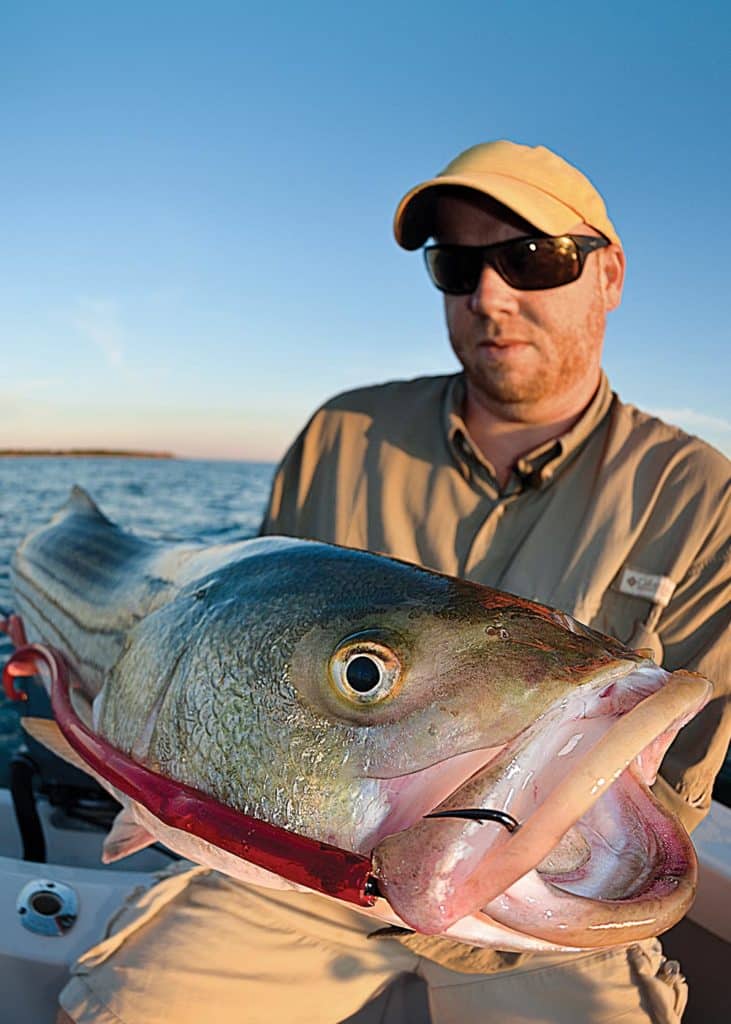
Where to Catch Striped Bass in California
By Angelo Cuanang
San Francisco Bay striper fishermen get serious in the spring, when school fish from 3 to 12 pounds begin responding well to both live baits and artificial lures. During the spring season, boating anglers do best from lower San Pablo Bay south to Bluff Point, along the Marin shoreline. The game plan calls for light tackle, and casting to rocky points and shorelines, shallow flats, coves and islands.
Stripers prowl the current eddies that form behind the rocky edges and points on both the incoming and outgoing tides. Knowing where to catch striped bass is only the half of it. Make sure to approach within casting range, and then hold the boat in position while casting bucktail jigs or swimbaits into current seams.
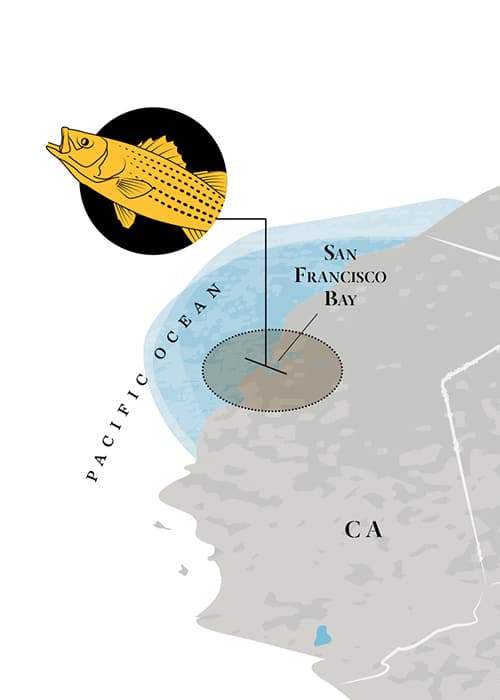
Experienced anglers favor ½- to 1-ounce white bucktail jigs, ½-ounce Rat-L-Traps in natural colors, and 3- to 4-inch swimbaits in natural baitfish colors fished on ½-ounce heads.
Traveling south from here into the main bay, the Berkeley Flats offer prime grounds for drifting live anchovies. Use a 7-foot live-bait action rod and a live-bait rig with enough weight to hold bottom, usually 2 to 8 ounces, depending on the water depth and current. Other areas that also offer good live-bait action in the main bay are the waters near Alcatraz, such as Sam’s Reef, the Rockpile and Harding Rock. Raccoon Straits near Angel Island also produces good numbers of stripers.
Later in the season, summer through fall, look for the best action farther west of San Pablo Bay in the West Delta, around Pittsburg, below the confluence of the Sacramento and San Joaquin rivers.
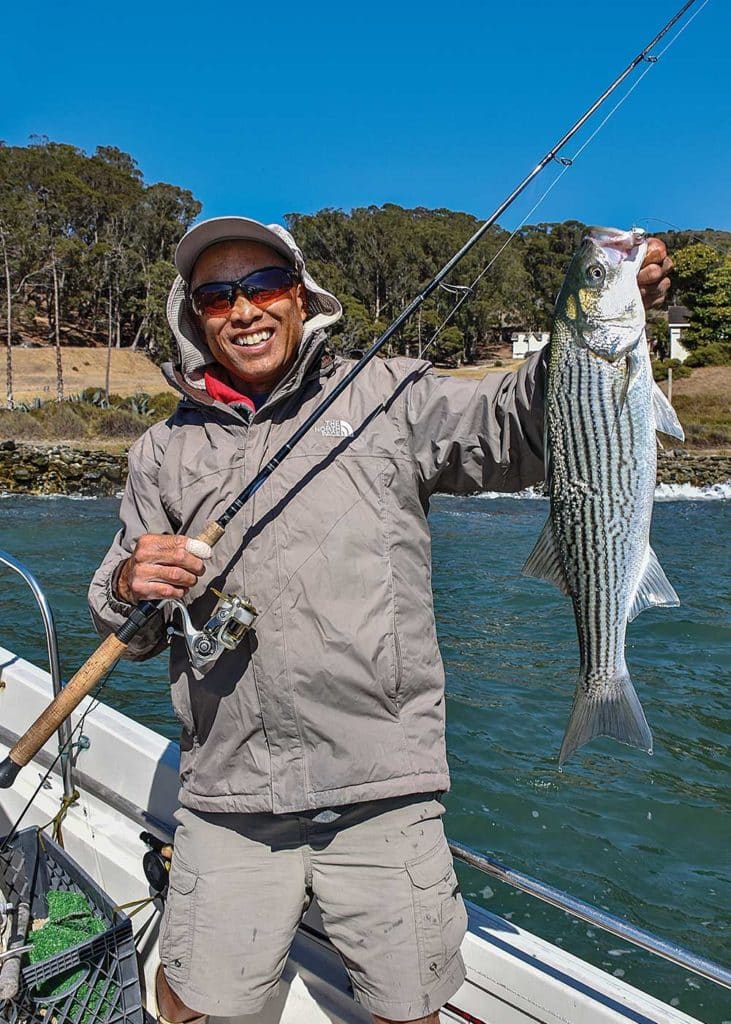
Bass forage on the bottom this time of year, so the best results come with live baits drifted deep through promising-looking channels and around bait-gathering structure and bottom features. For the most action with keeper-size fish, concentrate on shallow flats, channel edges, islands, cuts and points, focusing on water 5 to 15 feet deep. Such areas hold trophies too — stripers that may approach the 50-pound mark. Also key on the slopes of deeper cuts and channels in 25 to 35 feet, using big live baits — either jacksmelt or splittail — on a sliding sinker rig.
This massive expanse of water need not be intimidating. Just identify bottom structure such as reefs, humps and bars — places where baitfish tend to congregate — and that’s where you’ll find the stripers.
Deeper-water structure is often best covered with either big live baits or metal jigs and spoons.
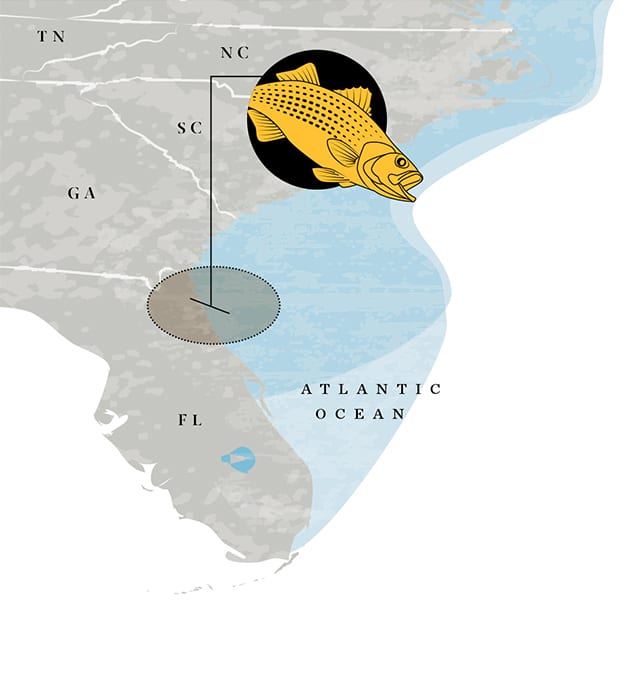
Catching Striped Bass in Florida
By Capt. Dave Lear
Stripers historically resided in the brackish waters near Jacksonville, Florida, but changing environmental conditions caused reproduction to fizzle by the early 1970s. A joint restocking program by the state’s Fish and Wildlife Conservation Commission and the U.S. Fish and Wildlife Service, along with the abundance of cool-water springs in the St. Johns River basin, now supports a smaller population.
“Prime time is December through February,” says Capt. Chris Holleman of Jacksonville. “There are some holes 77 feet deep in the St. Johns that offer thermal refuge. We still catch stripers sometimes in the summer. But in the winter they are fat and sassy. My two biggest were 25.5 and 19.6 pounds.”
The stocking program boosted numbers in the St. Johns and Nassau rivers, and Georgia’s bordering St. Marys. Spots such as the railroad trestle in downtown Jacksonville, the I-95 bridge, the Humpback Bridge near Boggy Creek, Loftin Creek off the Nassau River, and residential docks all hold stripers, often mixed among redfish and seatrout.
“The best action is when the weather is nasty,” Holleman says. “They really bite well right before a front when the pressure is falling. And the less salinity, the better.”
Holleman says a fish-finder rig with cut mullet is most commonly used. However, he prefers to throw large artificial lures, especially swimmers that mimic finger mullet.
“I use lures up to 7 inches long,” Holleman says. “The Cotton Cordell Hot Spot, Bomber bucktails with white curly-tail grubs, and the Smithwick Perfect Rogue lures are all good. My favorite colors are silver sides with blue or black backs.”
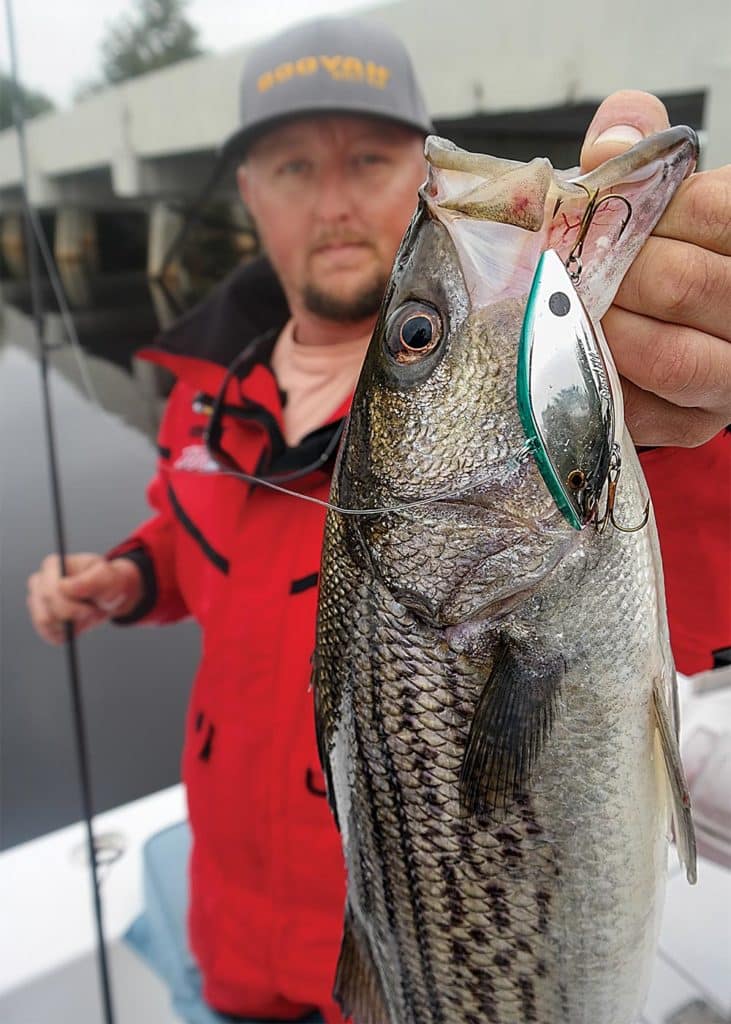
When conditions are right, fish come to the surface to chase bait, making lures more effective. He casts beyond bridge pilings and other structure, and lets the current sweep the plugs past the pilings. Vertical jigging with ¼- to ½-ounce jigs and pearl soft-plastic paddle-tail lures in the backwater eddies is another consistent tactic.
Tackle consists of stout baitcasting rods matched with reels loaded with 20-pound mono. “I like how the mono stretches, yet it still gives me enough strength to horse ’em a bit,” Holleman says. For vertical jigging, he switches to 20-pound braid with a 20-pound fluorocarbon leader.
“I really enjoy catching stripers,” he says. “They fight hard in the colder months, plus they take pressure off our other local game fish like redfish, trout and flounder. I just wish we had more stripers here than we do.”
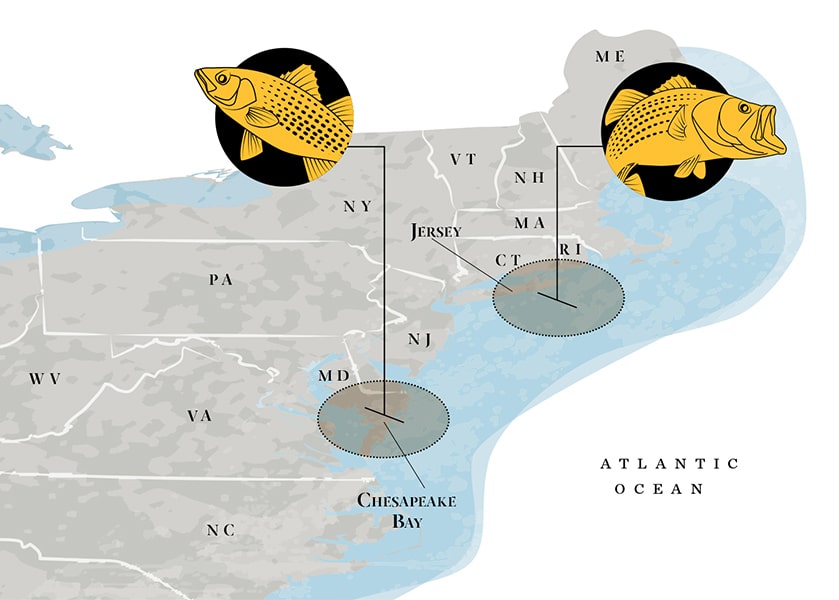
Mid-Atlantic Striper Central
By Ric Burnley
The fate of striped bass rises and falls in Chesapeake Bay, North America’s largest estuary, where 70 percent of the world’s stripers, locally called rockfish, are born and raised. Capt. Pete Dahlburg has been chasing them here for almost 20 years.
He starts his year in mid-April, searching the shallows of the Eastern Shore islands. “As soon as the water temperature rises above 50 degrees, bait moves into the shallows and the rockfish follow,” he says.
Current rips, points and channel edges provide cover for the bait and a corral for the striped bass. “The backwater can be 10 degrees warmer than the main bay,” he says.
“When the fish spread out or the water is stained, a Rapala X-Rap 12 calls them in.” When Dahlburg finds schools of stripers, he goes to soft plastics.
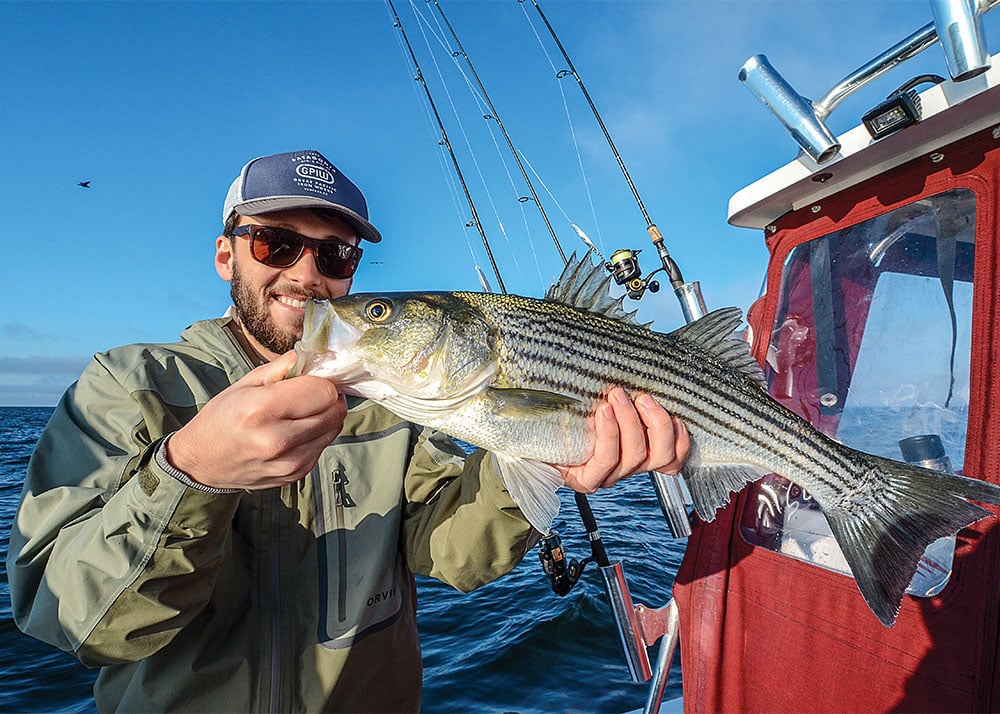
By mid-May, the rockfish move onto grass flats. “Search Google Earth satellite photos for dark bottom in shallow coves,” Dahlburg says. To target fish on the flats, he switches to a weedless soft plastic on a ¼-ounce jig head or a walk-the-dog-type topwater lure. “We can catch a hundred fish a day,” he says.
As spring turns to summer, rockfish move into the open bay over “lumps, humps and bumps.” Early in the morning, he looks for rock piles and drops in shallow water. When the sun is high, he moves deeper and looks for fish on old ballast stone reefs and channel edges. A 1½-ounce skirted jig head with a 6-inch BKD soft plastic is heavy enough to hit bottom and big enough to get the fish’s attention.
By late summer, Dahlburg finds stripers chasing silversides in open water. Diving birds indicate feeding fish. To match the hatch, he casts a 1-ounce Dirty Dick spoon into the school, giving the lure a slow count that puts it in the strike zone before retrieving.
As the water temperature drops in early fall, Dahlburg looks for the fish to settle in Eastern Shore shallows again. “Temps below 75 spark the bite, and 60 to 70 degrees is primo,” Dahlburg says. Most days, the fish hold around any structure that meets current.
The action is year-round, if you know where to look.
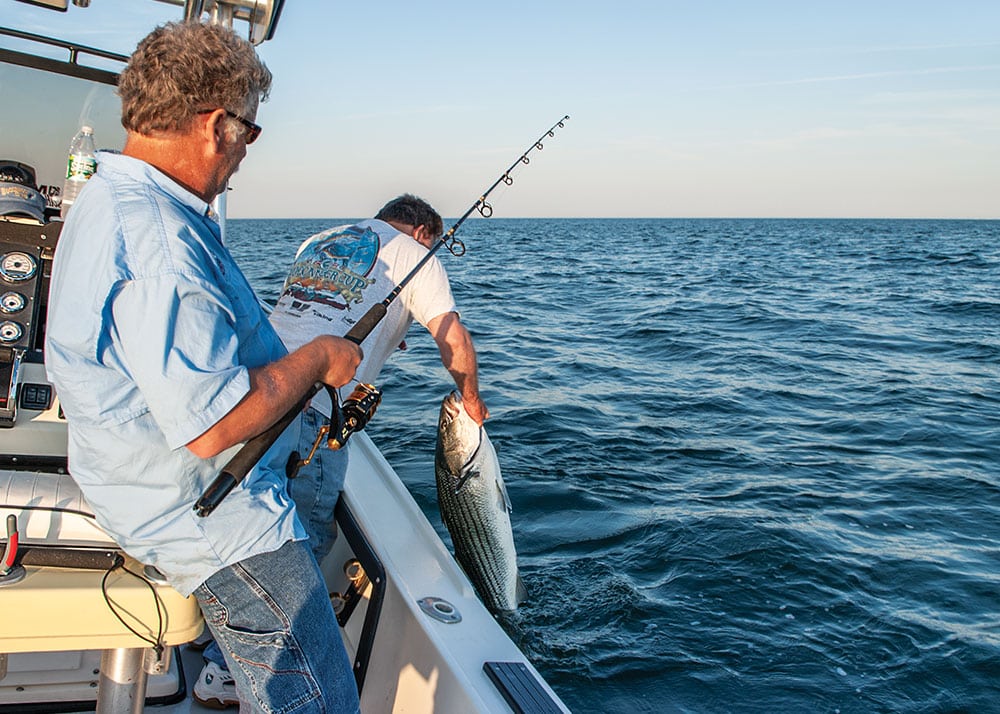
Follow the Bunker for Jersey Bass
By Nick Honachefsky
New Jersey boasts two out of three of the world’s major striped bass spawning grounds because migrating schools pass through Delaware Bay up the Delaware River, and through Raritan Bay to egg out in the Hudson River.
“In late March or early April, I’ll troll light plugs like Rapala Magnum X-Raps, or set up on a clam chum slick to get those slow-moving, first-wave fish biting,” says Freddy Gamboa of Andrea’s Toy Charters. “But the real run doesn’t kick off until May or early June when the bunker (menhaden) move through.”
Live-lining bunker is a staple of the north and central Jersey fishery, with large, adult bunker live-lined on 10/0 Gamakatsu circle hooks. Bunker also play a big role in Delaware Bay as bass hounds chunk fresh bunker in the cuts at 60-foot Slough, the Horseshoe and 20-foot Slough.
“Once those first-run bass drop their eggs and move down out of the Hudson, the Verrazano Bridge and Romer Shoal turn hot. However, it’s that second wave of migratory Chesapeake fish, the 25- to 45-pounders that follow the 55-plus- degree water chasing bunker schools, that really sparks the run in mid-May,” Gamboa adds.
Break out large Yo-Zuri Bull Poppers, Storm Swim Shads and swimming plugs for casting, or troll with chartreuse or white Mojo balls and Tony Maja spoons in the 35- to 65-foot depths off Spring Lake down to Island Beach State Park.
A consistent bite can lie anywhere from Barnegat Inlet to Manasquan Inlet up to Ambrose Light.
Read Next: Striper Fishing Around Bunker Schools
Jersey anglers get sporadic shots at resident bass during summer, usually by drifting live eels or sand worms during night hours around back-bay bridges in Ocean City, the Manasquan River, off the Highlands Bridge, or by drifting live spot during daytime through deep cuts and holes at Swash Channel, Barnegat Inlet or the Cape May Rips.
Come October, striper schools returning from New England pass through Hell’s Gate into the Hudson River, and hang around the Statue of Liberty until November.
“In autumn, we search for birds diving on sand eels, rainfish, bunker and herring schools,” Gamboa says. “The bite can be from Breezy Point off Brooklyn down to off Asbury Park, jigging with metals like Deadly Dicks, Ava jigs and Kroc spoons, or trolling Maja bunker spoons, shad bar rigs and 9er’s umbrella rigs.”
Fall striper fishing is fast and furious as schools explode on bait throughout the day. November is the peak month for striper action, pushing into December as the last movement of larger fish makes its way through, leaving schoolies of 18 to 27 inches behind for the bulk of the action to round out the year.
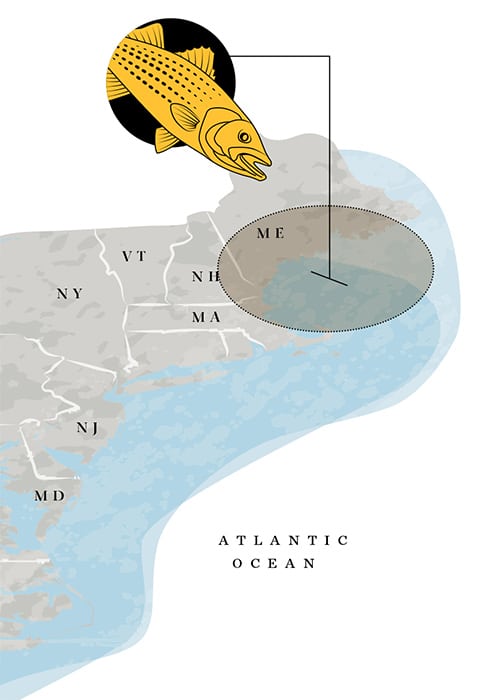
New England Rendezvous
By Barry Gibson
Boston Harbor
“The bass and mackerel always seem to arrive on Mother’s Day,” says Pete Santini, proprietor of Fishing Finatics Tackle Shop in Everett, Massachusetts. “The bass come into the harbor to chase herring at the mouths of the Mystic and Charles rivers, so we cast rubber-tail shads in silver-blue or bone white, but they’ll hit topwaters and jigs as well.
“In June and July, I slow-troll live mackerel pinned through the nose on lead-core in deep water around Egg Rock, and Deer, Georges, Spectacle and Long islands.” At high tide, Pete slow-trolls the shallower areas with his famous Santini Tube lure sweetened with a sand worm. “Low and slow is the key. You want that tube moving along just off the bottom,” he advises.
“When the pogies (menhaden) arrive in late July, we’ll snag one and pull it away from the school. No need to rehook it, just drift and wait for a bass to slam it. We also troll big wooden, lipped swimming plugs at night over the reefs and ledges in the harbor and take some big bass, better than 50 pounds.”
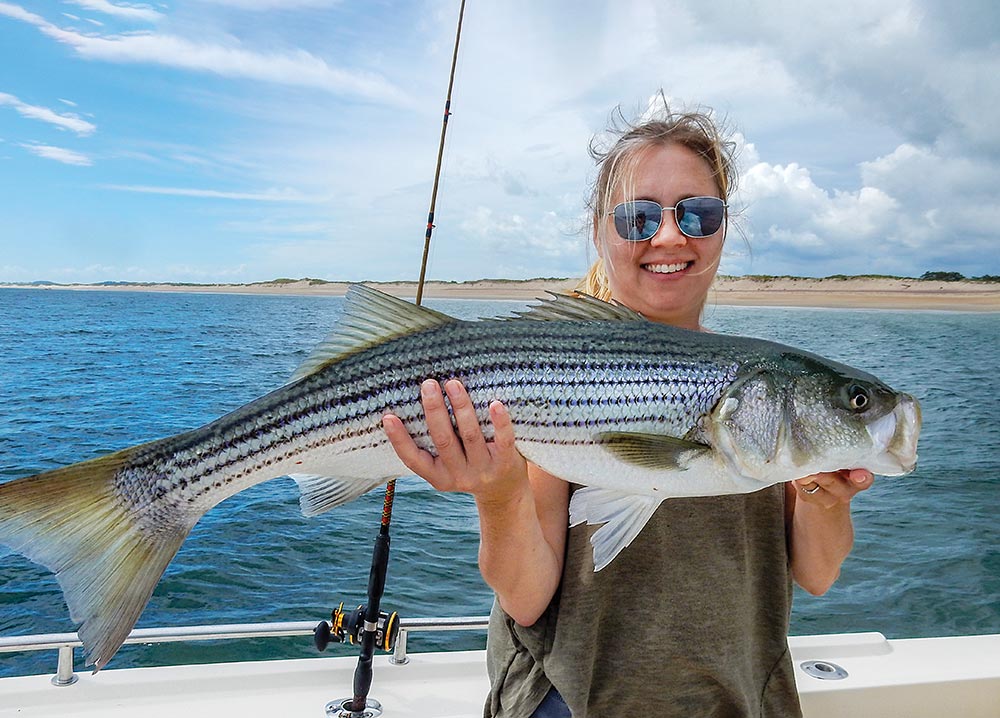
Newburyport, Massachusetts
Forty miles north of Boston, veteran guide Capt. Scott Maguire of Summer Job Charters (summerjobcharters.com) heads into his 21st season chasing stripers around the Merrimack River. “The schoolies show up in early May, and we’ll target them with 3-inch soft plastics, ⅜-ounce jigs, and 4-inch stickbaits. Early on, the best spots are upriver of the marinas where the water warms during the day. Later, the fish drop down to Joppa Flats, closer to the mouth,” he says.
The bigger bass and the mackerel arrive a couple of weeks later. “We’ll deep-drift the mouth of the river, or slow-troll macks on 20-pound outfits and 6/0 circle hooks along the beaches, outside the river mouth,” he says. “We’ll also back into the surf in 4 feet of water, and cast liveys as close to the sand as we can. These are top tactics for taking bigger bass to 40 inches.”
Maguire says that slow-trolling and beach-casting are productive right into the first week of October.
Kennebunkport, Maine
Capt. Greg Metcalf, who’s been running striped bass charters in Striper Swiper for nearly 30 years, says water temp is the key in spring in southern Maine. “The bass and mackerel arrive the last week in May to the first week in June, when the water hits 50 degrees,” he says. “The first bass are usually small, but a week later we get a mix of fish including some jumbos, and they’re all feeding on the macks.”
In the early weeks, Metcalf fishes live mackerel on state-mandated circle hooks. “We get them on flies and topwater poppers at first light, but when the sun gets high, it’s live or chunk mackerel.
“In July and August when the water warms into the 60s, the bass get sluggish, and we do more chunking. But this past season, the pogies arrived with big stripers under some of the schools. We’d throw live macks or pogies into these bait pods, and were occasionally rewarded with a 25-pound bass.”









